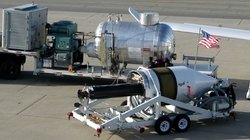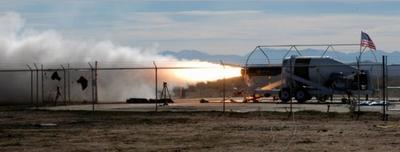Propulsion Technology Spin-Off From SpaceShipOne Program
SpaceDev has created a propulsion program that includes the
SpaceDev Streaker™ -- a low-cost small launch vehicle -- an
orbital transfer space tug -- and other propulsion products based
in part on SpaceDev's development of a hybrid rocket motor related
to the SpaceShipOne vehicle announced by Scaled Composites earlier
this month.
 "SpaceDev is proud to be on the leading-edge of
safe, affordable human space flight with its patented, safe hybrid
rocket propulsion systems," said Jim Benson, founding chairman and
chief executive of SpaceDev. "With the recent success of the
SpaceDev-built CHIPSat high performance microsatellite, growing
demand for responsive microsats and space control by the military,
and the successful testing of our larger hybrid rocket motor under
the SpaceShipOne program, SpaceDev is closer to accomplishing the
comprehensive private space program and family of products we have
been developing since our founding."
"SpaceDev is proud to be on the leading-edge of
safe, affordable human space flight with its patented, safe hybrid
rocket propulsion systems," said Jim Benson, founding chairman and
chief executive of SpaceDev. "With the recent success of the
SpaceDev-built CHIPSat high performance microsatellite, growing
demand for responsive microsats and space control by the military,
and the successful testing of our larger hybrid rocket motor under
the SpaceShipOne program, SpaceDev is closer to accomplishing the
comprehensive private space program and family of products we have
been developing since our founding."
Over the last three years SpaceDev has worked to design a
practical, expendable small launch vehicle named SpaceDev Streaker.
SpaceDev Streaker will be capable of putting 1,000 pound payloads
-- CAVs and one or more microsatellites -- into low earth orbit at
a price expected to be less than existing or planned small launch
vehicles.
Automotive Tech?
The SpaceDev Streaker will use patented High Performance Mass
Fraction™ hybrid common core boosters that will equal the
performance of solid rocket motors and some liquid rocket motors
while remaining safe, responsive and affordable. The rocket
motors burn HTPB (tire rubber) and Laughing Gas (nitrous
oxide), and will be augmented by existing technologies to produce
performance significantly above traditional hybrid motors. Those
boosters will form the base of a family of SpaceDev propulsion
products, including sounding rockets, strap-on boosters, targets,
payload accelerators, and for other commercial and military
applications.

As part of this SpaceDev propulsion program, SpaceDev is
designing and building a previously announced highly innovative and
unique Shuttle- and EELV secondary compatible orbital transfer
"space tug" under a contract with the Air Force Research Lab
(AFRL). The SpaceDev MTV™ (orbital Maneuvering and orbital
Transfer Vehicle) and the space tug both use hybrid rocket motors
fueled by Plexiglas™ (PMMA) and Laughing Gas (nitrous oxide).
A SpaceDev MTV can accelerate from zero to over 3,000 MPH
in under four minutes. The SpaceDev space tug for AFRL
will be capable of raising or lowering a small payload by hundreds
of miles, while SpaceDev MTVs will be capable of raising and
lowering payloads by thousands of miles.
"We expect the market for hybrid-based products to grow because
of their low-cost and increased customer interest in safety,
responsiveness and affordability," said Richard Slansky, chief
financial officer for SpaceDev. "There are numerous emerging
applications for this technology."
SpaceDev's high performance hybrid rocket propulsion, and its
orbital maneuvering and orbital transfer technology, is of growing
importance for space situational awareness, satellite inspection,
counter measures, satellite rescue, refueling, small launch vehicle
boosters and upper stages, and other applications, both commercial
and military.
 Aero-News: Quote of the Day (04.28.25)
Aero-News: Quote of the Day (04.28.25) ANN's Daily Aero-Term (04.28.25): Decision Altitude (DA)
ANN's Daily Aero-Term (04.28.25): Decision Altitude (DA) ANN's Daily Aero-Linx (04.28.25)
ANN's Daily Aero-Linx (04.28.25) Airborne-Flight Training 04.24.25: GA Refocused, Seminole/Epic, WestJet v TFWP
Airborne-Flight Training 04.24.25: GA Refocused, Seminole/Epic, WestJet v TFWP Aero-News: Quote of the Day (04.29.25)
Aero-News: Quote of the Day (04.29.25)




